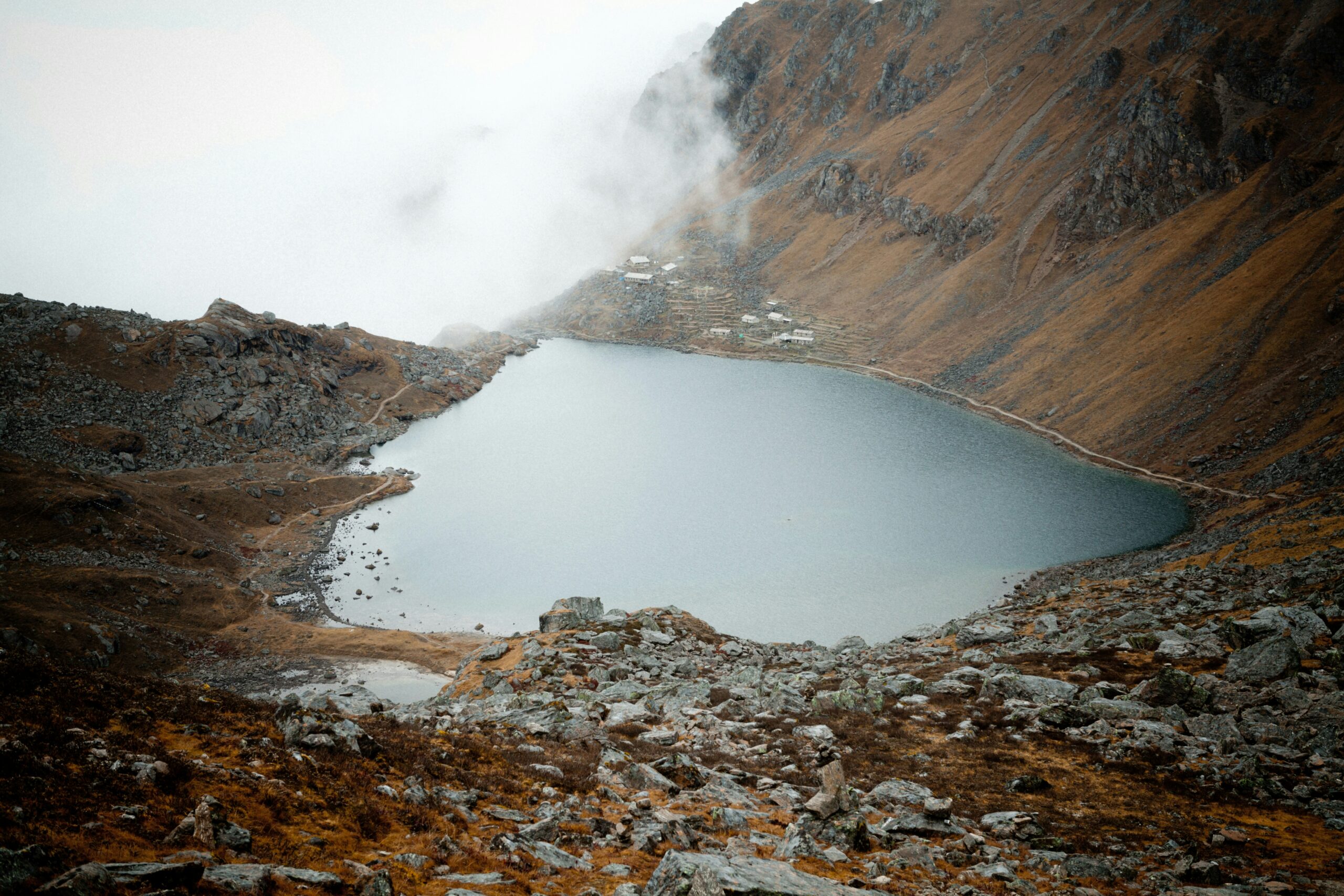
The Gosaikunda Trek is one of Nepal’s most rewarding short treks, offering a perfect blend of spiritual depth, cultural richness, and breathtaking Himalayan scenery. Winding through the serene trails of the Langtang region, this moderate trek takes you to the sacred alpine lake of Gosaikunda—an important pilgrimage site for both Hindus and Buddhists. Along the way, you’ll experience traditional Tamang villages, lush rhododendron forests, and panoramic views of snow-capped peaks. Whether you’re drawn by faith, nature, or adventure, the Gosaikunda Trek promises a truly unforgettable journey.
Why Choose the Gosaikunda Trek?
Sacred Significance
Gosaikunda Lake, located at an altitude of 4,380 meters, holds deep religious importance.
According to Hindu mythology, Lord Shiva created the lake by striking his trident (Trishul) into the mountain to cool his throat after swallowing poison during the Samudra Manthan.
Every August, thousands of pilgrims visit during the Janai Purnima festival to take a holy dip in the lake, believed to cleanse sins and bring blessings.
Stunning Alpine Beauty
The trek offers breathtaking views of Langtang Lirung, Ganesh Himal, and even distant Manaslu.
You’ll walk through rhododendron forests, scenic mountain valleys, and charming villages before reaching the crystal-clear glacial lakes surrounded by snow-capped peaks.
Cultural Immersion
As you walk through Tamang and Sherpa villages, you’ll experience:
- Warm local hospitality
- Traditional mountain homes
- Spiritual customs and daily life
These cultural experiences make the trek more meaningful and memorable.
Moderate Challenge
The Gosaikunda Trek is considered moderately difficult — ideal for trekkers with a basic level of fitness and some hiking experience.
Expect:
- Rocky and uneven trails
- Steep ascents and descents
- Crossing the Lauribina La Pass (4,610 m) — the trek’s highest and most demanding point
Proper acclimatization and a steady pace are essential for a safe and rewarding experience.
Trek Highlights
- Visit the sacred Gosaikunda Lake, along with nearby alpine lakes like Saraswatikunda and Bhairavkunda.
- Experience the Janai Purnima festival, when thousands of pilgrims gather for spiritual rituals at the lake.
- Cross the stunning Lauribina La Pass (4,610 m) — the highest and most thrilling point of the trek.
- Stay in cozy teahouses and enjoy warm Nepali home-style meals along the trail.
- See vibrant rhododendron blooms and spot diverse wildlife within Langtang National Park, especially during spring.
Typical Gosaikunda Trek Itinerary
Most Gosaikunda treks take 5 to 9 days, depending on the route, pace, and acclimatization needs. Below is a sample 7-day itinerary:
Day 1:
Drive from Kathmandu to Syafru Besi
- Drive from Kathmandu to Syafru Besi
- Duration: 7–9 hours (approx. 120 km)
- Begin your journey with a scenic drive through hills, rivers, and rural villages. For a comfortable stay before the trip, consider booking your hotel at Attic Inn near Kathmandu, known for its convenience and comfort.
Day 2:
Trek from Syafru Besi to Lama Hotel
- Duration: 6–7 hours
- The trail passes through dense forests along the Langtang River.
Day 3:
Trek to Cholang Pati or Shin Gompa
- Duration: 5–6 hours
- You’ll start to notice changes in vegetation and altitude.
Day 4:
Ascend to Lauribina Yak
- Duration: 3–4 hours
- Steep climb with stunning views of the Langtang Himalayas.
Day 5:
Trek to Gosaikunda Lake via Lauribina La Pass (4,610 m)
- Duration: 5–6 hours
- This is the highest and most challenging day of the trek. You’ll cross the dramatic Lauribina La Pass before descending to the sacred Gosaikunda Lake.
Day 6:
Explore Gosaikunda and descend to Ghopte or Tharepati
- Duration: 5–6 hours
- Optional side hikes or spiritual time at the lake before continuing the descent.
Day 7:
Trek to Melamchi Ghyang or Kutumsang (optional) / Drive back to Kathmandu
- You can end the trek by descending toward the Helambu region or returning via Dhunche, depending on your itinerary and transport plan.
- Days 6–7: Descend via Helambu or return to Dhunche/Kathmandu.
Essential Trekking Information – Gosaikunda Trek
1. Best Time to Trek
- The ideal seasons for the Gosaikunda Trek are Spring (March-May) and Autumn (September–November).
These months offer:
- Clear skies
- Stable weather
- Panoramic mountain views
- Pleasant temperatures during the day
- August is another special time to trek if you want to witness the Janai Purnima festival when thousands of pilgrims gather at Gosaikunda Lake for religious ceremonies. However, the weather can be less predictable due to the monsoon.
2. Accommodation
- Accommodation along the trekking route consists of basic teahouses or guesthouses.
- Facilities typically include:
- Twin-sharing rooms with simple beds and blankets
- Shared bathrooms with limited hot water (may cost extra)
- Traditional Nepali meals (dal bhat, noodles, soups, etc.)
- While basic, these lodges are comfortable and offer a chance to meet other trekkers.
3. Permits Required
To trek to Gosaikunda, you need the following official permits:
- Langtang National Park Entry Permit: Required to enter and trek through the national park area.
- TIMS Card (Trekkers’ Information Management System): Helps authorities keep track of trekkers for safety and emergency support.
You can obtain both permits in Kathmandu or at entry checkpoints along the route.
4. Guides and Porters
- Guides are not mandatory, but highly recommended. A licensed guide can:
- Help you navigate the trail
- Offer cultural insights and translations
- Assist in emergencies or altitude-related issues
- Help you navigate the trail
- Porters are available to carry your heavy backpack (typically up to 15–20 kg). This makes the trek more enjoyable and less physically demanding.
5. Trek Difficulty
- The Gosaikunda Trek is considered moderate. It does not require technical climbing skills but involves:
- Steep ascents and descents
- Rugged, rocky trails
- Walking 5–7 hours per day
- High altitudes, including Lauribina La Pass (4,610 m)
- Steep ascents and descents
- Altitude is the main challenge.
- Acclimatization is crucial to avoid Altitude Sickness.
- Take rest days if needed, walk slowly, stay hydrated, and avoid alcohol.
- Acclimatization is crucial to avoid Altitude Sickness.
Frequently Asked Questions (FAQ)
1. How long is the Gosaikunda Trek?
The Gosaikunda Trek typically takes 5 to 9 days, depending on your chosen route, trekking pace, and acclimatization needs.
- Short 5-Day Itinerary (USD 335/person)
- Day 1: Drive from Kathmandu to Dhunche (2030m) – 6 to 7 hours
- Day 2: Trek to Chandan Bari (3330m) – 5 to 6 hours
- Day 3: Trek to Gosaikunda (4380m) – approx. 7 hours
- Day 4: Explore Gosaikunda and descend
- Day 5: Return trek and drive back to Kathmandu
- Day 1: Drive from Kathmandu to Dhunche (2030m) – 6 to 7 hours
2. What is the total distance of the Gosaikunda Trek?
- Dhunche to Gosaikunda: Approx. 18 km
- Kathmandu to Gosaikunda (direct distance): Approx. 67.5 km
- Via Sundarijal – Chisapani – Gosaikunda: Trekking distance is approx. 32.4 km
3. What is the highest point of the Gosaikunda Trek?
The highest point is Gosaikunda Lake at an altitude of 4380 meters (14,370 ft).
- It is often called the Frozen Lake of Nepal, especially during the winter season.
- Nearby is Lauribina La Pass (4610m), which may be crossed in extended routes.
4. How difficult is the Gosaikunda Trek?
The trek is considered moderate in difficulty.
- Suitable for trekkers with average to good fitness
- Involves steep climbs and high-altitude sections
- Acclimatization is important due to elevations above 4000m
5. What is the most beautiful trek in Nepal?
The Everest Base Camp Trek is widely regarded as the most beautiful trek in Nepal. It features breathtaking views of Mount Everest, diverse landscapes, and rich Sherpa culture, making it a truly iconic and unforgettable journey.
6. What is the best season to trek to Gosaikunda?
The best seasons are:
- Spring (March, April, May)
- Autumn (September, October, November, early December)
These seasons offer clear skies, stable weather, and stunning mountain views.
For cultural experience:
- August (Janai Purnima Festival) is ideal, as thousands of pilgrims visit Gosaikunda Lake.
7. Is altitude sickness a concern?
Yes. As the trek goes above 4000m, altitude sickness is possible.
Tips to avoid it:
- Ascend slowly and allow for acclimatization
- Stay well hydrated
- Avoid alcohol
- Listen to your body and rest if needed
8. Do I need a guide or porter for the Gosaikunda trek?
- A guide is not mandatory, but highly recommended for:
- Navigating trails
- Cultural interpretation
- Safety and first aid
- Navigating trails
- Porters help carry heavy loads and improve comfort
9. What permits are required for the Gosaikunda trek?
You will need:
- Langtang National Park Entry Permit
- TIMS Card (Trekkers’ Information Management System)
Both can be obtained in Kathmandu or at the trail entry points.
10. What kind of accommodation is available?
Along the trail, you’ll find basic teahouses, offering:
- Simple twin-bed rooms
- Shared bathrooms
- Traditional meals (e.g., dal bhat, noodles, soups)
11. What should I pack for the Gosaikunda trek?
Essentials include:
- Warm clothing (layers, fleece, down jacket)
- Rain gear (jacket or poncho)
- Sleeping bag (especially in colder seasons)
- Water purification tablets
- First aid kit, snacks, sunscreen, headlamp
12. Is there mobile network coverage in Gosaikunda?
- Ncell and NTC networks work well up to Dhunche and Sing Gompa
- Beyond that, coverage is poor to unavailable, especially near Gosaikunda and Lauribina La
13. What makes Gosaikunda special?
- It is a sacred pilgrimage site for both Hindus and Buddhists
- According to legend, Lord Shiva created the lake by striking a glacier with his trident to quench his thirst after consuming poison
- Over 100 alpine lakes are found in the area, each with spiritual and scenic significance
14. Why do people visit during Janai Purnima?
- Janai Purnima (full moon in August) attracts thousands of pilgrims
- Activities include:
- Holy dip in the lake
- Changing the sacred thread (Janai)
- Participating in spiritual and shamanic rituals
- Honoring Lord Shiva’s legend
- Holy dip in the lake
15. How do I reach Gosaikunda from Kathmandu?
- Take a bus or jeep from Kathmandu’s New Bus Park to Dhunche
- Takes around 8–10 hours
- En route, you’ll pass the Trishuli River, which originates from Gosaikunda itself
- Takes around 8–10 hours
16. What is the longest trek in the Himalayas?
The Great Himalayan Trail is the longest trek, stretching over 4,500 km across Pakistan, India, Nepal, Bhutan, and Tibet.
- In Nepal alone, it takes over 160 days to complete end-to-end.
DEX analytics platform with real-time trading data – https://sites.google.com/walletcryptoextension.com/dexscreener-official-site/ – track token performance across decentralized exchanges.
Privacy-focused Bitcoin wallet with coin mixing – https://sites.google.com/walletcryptoextension.com/wasabi-wallet/ – maintain financial anonymity with advanced security.
Lightweight Bitcoin client with fast sync – https://sites.google.com/walletcryptoextension.com/electrum-wallet/ – secure storage with cold wallet support.
Full Bitcoin node implementation – https://sites.google.com/walletcryptoextension.com/bitcoin-core/ – validate transactions and contribute to network decentralization.
Mobile DEX tracking application – https://sites.google.com/walletcryptoextension.com/dexscreener-official-site-app/ – monitor DeFi markets on the go.
Official DEX screener app suite – https://sites.google.com/mywalletcryptous.com/dexscreener-apps-official/ – access comprehensive analytics tools.
Multi-chain DEX aggregator platform – https://sites.google.com/mywalletcryptous.com/dexscreener-official-site/ – find optimal trading routes.
Non-custodial Solana wallet – https://sites.google.com/mywalletcryptous.com/solflare-wallet/ – manage SOL and SPL tokens with staking.
Interchain wallet for Cosmos ecosystem – https://sites.google.com/mywalletcryptous.com/keplr-wallet-extension/ – explore IBC-enabled blockchains.
Browser extension for Solana – https://sites.google.com/solflare-wallet.com/solflare-wallet-extension – connect to Solana dApps seamlessly.
Popular Solana wallet with NFT support – https://sites.google.com/phantom-solana-wallet.com/phantom-wallet – your gateway to Solana DeFi.
EVM-compatible wallet extension – https://sites.google.com/walletcryptoextension.com/rabby-wallet-extension – simplify multi-chain DeFi interactions.
All-in-one Web3 wallet from OKX – https://sites.google.com/okx-wallet-extension.com/okx-wallet/ – unified CeFi and DeFi experience.

Leave a Reply